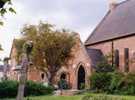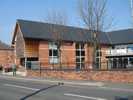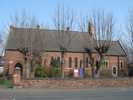For this church:    |
|
| Date | Population of Netherfield |
| 1861 | 68 - Netherfield was first recorded separately |
| 1871 | 67 |
| 1881 | 735 - 242 males of which 203 worked employed as ‘Railway workers’ |
| 1891 | 2468 |
| 1901 | 4646 |
| 1911 | 6386 |
| 1921 | 7104 |
| The population of Netherfield has remained stable at 6000 to 7000 since 1921 |
Until housing development in the 1870s most of the railway workers would have lived in adjacent Carlton or in the eastern suburbs of Nottingham, travelling freely to work by train.
In the early 1870s the Rector of Gedling, Canon Forester (later Lord Forester) witnessing the growth of Netherfield, proposed the establishment of two new parishes each with its own church. One to serve Carlton (St Paul’s) the other to be St George’s at Netherfield. The Patron of Gedling Church at the time was the Earl of Carnarvon, who also owned most of the land in the area. He disagreed, stating that there were very few dwellings in Netherfield, so no action was taken. The Earl’s family had over the previous thirty years acquired considerable income from the sale of land to the railway companies.
Perhaps due to the increasing numbers of dwellings built in the next decade, mostly on land purchased from the Earl, when Canon Forester raise the issue again in 1884 it was accepted. On 21st August 1885 the two parishes were established by Order of Council, and the church building programme was initiated. The Earl gave a parcel of land - the present site, nearly one acre in size - and donated £100 towards the building costs. At the same time he gave the land for the building of St Paul’s Carlton, and over time paid most of the St Paul’s building costs. The Earl retained Patronage over all three new parishes. Gedling being a reasonably wealthy church was able to offer the clergy of St George’s a living of £302 per annum. Initially a corrugated iron church was quickly erected on Meadow Lane whilst a permanent building was planned.
The design of the church was entrusted to Mr Ewan Christian, one of the most notable architects of the day. Ewan Christian was in 1885 nearing the end of his distinguished career, being aged 71 years of age at the time. He was born in the Isle of Man where many churches he designed can be seen. During his career he was elected President of the Royal Institute of British Architects in 1884, and was responsible for the restoration of Southwell Minster, Chester Cathedral and the design of the extension of the National Gallery in London to create the National Portrait Gallery. He is accredited with the design of over 40 new churches, 200 parsonages and is reported to have been involved with other work on over 2000 ecclesiastical buildings, plus schools, country houses, banks, public buildings and industrial premises. The church was constructed by a local builder Thomas Fish, whose company still operates in 2007.
The estimated cost of the church was recorded as £2600. The actual cost is variously recorded as £2400 to £2500, all but £100 of which was raised before it was completed. The two railway companies jointly donated £150, and the railway workers are said to have contributed significantly. As a cost comparison St Paul’s Carlton cost £10,000 by the time it was completed in 1910, and nearby Colwick Vale Congregation Church costs £1000 in 1907.
On the 9th July 1886 the foundation stone was laid by Lady Forester. The building being consecrated on the 24th of May 1887 by the Archbishop of York, Dr W Thomason. The Nottingham Journal reported that ‘the turn out was good despite the weather’ and that the psalm sung was ‘All people that on earth do dwell’.
At the time the new church was opened the vicarage had not been built, but this was soon in hand. It was designed by Messrs Goddard and Son of Lincoln, and built by Otter and Brighton at a cost of £1500 which was met by the Ecclesiastical Society. The first incumbent in the new church and vicarage was the Rev John Grenlaw who remained in post until 1899.
St George’s was not the first church to be built in Netherfield, a Methodist Church was open in 1886 also on Victoria Road almost opposite St George’s. It was demolished in the 1960s and a garage now occupies the site. Four other new churches were built in Netherfield between 1887 and 1902.
In 1886 the church acquired the lease of the Great Northern Railway Club, The Railway Tavern. Included in the transfer were ‘the beer engines, billiard tables and other items’. Lord Colville was elected President and the vicar appointed Treasurer. The rulebook states that: ‘The club must have at least 40 members, who shall pay 1/6 (One shilling and six pence) per quarter membership fee, plus 6d (six pence) entrance fee on each visit.’ It is not known how long the club survived or its actual location. Much later the church built an institute on land fronting Forester Street at the rear of the vicarage (now the site of the Medical Centre)
Few records are available which give any account of the church’s activities during its earliest days. However surviving faculty letters record some of the changes which have taken place. In 1901 the church had to pay its apportionment for the making up of Forester Street, a sum of £19 13s 9d being demanded. It was to be a further six years before a wall was erected along the Forester Street and Victoria Road boundaries, paid for by the Earl of Carnarvon at a cost of £100.
It can be assumed that upon completion the church was heated by coal stoves for in 1904 permission was given for the removal of two ‘Tortoise’ stoves - the same type of appliance recalled by John Betjeman in his well-known poem Christmas:
The bells of waiting Advent ring
The Tortoise stove is lit again
 The
roof line, with the The
roof line, with theventing lanterns still clearly visible |
Gas mains are believed to have been installed in the area sometime before 1901, so gas may have been provided in the church for both heat and light. This is a strong possibility, for by 1906 it was necessary to install a ventilation system into the church to deal with fumes. Air bricks with ducts were installed below the windows of the south and north walls and a lasting alteration to the roof line produced by the appearance of the two lantern shaped terminals to house the two Boyles Patent Air Pumps Pattern number 107. These were entirely mechanical devices operated by the rising warm air and draughts. The external housings are still in situ. It is not known if they contain any apparatus. It was not until 1927 that the church installed electricity.
In 1902 the congregation subscribed the sum of £16 to have the three plain east windows replaced by geometric patterned leaded lights in commemoration of the coronation of King Edward and Queen Alexandra.
Many men of Netherfield lost their lives in the First World War. In 1921 an oak screen surmounted by a crucifix and supporting figures was erected leading from the north wall towards the nave, forming an entrance to the Lady Chapel. The names of the local men who died in the Second World War were subsequently added.
The involvement of the church in the life of the local community was demonstrated by the somewhat unusual action of taking over the railway club lease in 1886, and later by the opening of church institute in the church grounds. It is further evidenced by the report of the church tennis club who used the courts at the rear of the church and were able to report that in December 1939 they had a cash balance in the club account of £71 11s 5d, a considerable sum at that time.
In 1947 major changes took place within the church. As a memorial to the previous incumbent the Rev Mr Truman, the east end leaded lights were boarded over to allow the chancel floor to be raised, and three new steps installed on which to place a new altar with a reredos curtain and crested frieze. At the same time the choir stalls were removed to the nave. The project costing £400.
A new reredos was also erected in the Lady chapel in 1960 again as a memorial.
At some point between 1887 and 1934 the Patronage of the church had been acquired by Harrogate College, Walsall, who in 1934 offered to sell it for the sum of £560. The congregation purchased it and it was transferred to the Southwell Diocesan Board of Patronage.
Like many churches, the church has in recent years been without the service of its own vicar on many occasions, and in 1981 it became a plurality with the neighbouring church of St John’s, Colwick.
In the year 2000 a proposal was made to demolish the church and replace it with a £750,000 multi-purpose building. Local opposition however defeated the idea and it was withdrawn. A new vicarage was built on the site of the tennis courts and in 2003 the old vicarage site was sold for the building of a new community facility. The St George’s Centre, opened in 2004.
 The
old vicarage (now demolished) The
old vicarage (now demolished) |
 The
new St George’s Centre The
new St George’s Centre |
Church Records
The church records date from 15th November 1885, when Emily Mable the daughter of Sam and Eliza Martin was baptised in a mission church built near the Colwick Railway crossing. Sam was a fireman working on the railway. The first baptism in the present building on 24th May 1887 was that of Alfreda Blalesley, daughter of William and Elizabeth Blalesley. William also worked on the railway, but was an engine driver.
Prior to the first baptism, a marriage ceremony had been conducted joining Herbert Palmer Redgrave aged 24 a builder, and Ann Pendle Henderson aged 23 on 24th January 1887. The Rev John Greenlaw the first vicar signed all three records.
The earlier registers have been deposited at the Nottinghamshire Archives Offices. The records include faculty letters with schedules of works, a newspaper report of the consecration of the church plus various correspondence, receipts for work done.
The local library at Carlton holds copies of more the recent Church Magazines.






